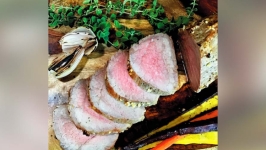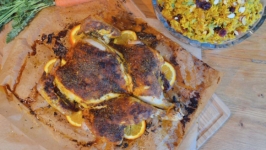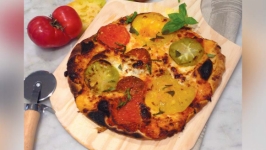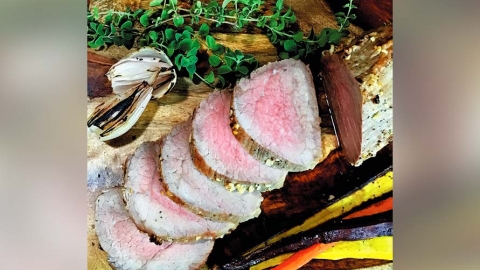Heating Up Some Great Winter Recipes
The weather outside might be frightful. But the aromas of that perfectly cooked beef roast that just came out of the oven? Well, that’s just plain delightful.
A blast of heat is a fast way to make a perfect roast beef, turn out a crispy whole chicken or create a restaurant-quality pizza at home. But before you crank up your oven to 500 degrees, make sure your oven is high-heat ready.
HIGH-HEAT COOKING TIPS
It may seem as if this first tip doesn’t have to be mentioned, but it’s time to fess up. When was the last time you really cleaned your oven? High heat is not a dirty oven’s friend. A smoke-filled kitchen isn’t the result you’re looking for.
Next, get the right high-heat “tools.” High heat can warp inexpensive pans, so invest in at least one top quality heavy-duty sheet pan. If you are going to be making a pizza using high heat, get a pizza stone and a pizza peel. The trick to restaurant-quality pizza crust is having a sizzling-hot pizza stone ready to greet your dough. Oven mitts that are made for high heat are also essential. Look for silicone mitts that are designed to be used in 500-degree temperatures.
And don’t forget to have an accurate food thermometer on hand. If you are tackling homemade pizza and making your own dough, you’ll want to test your water temperature. Yeast will not activate in water that is too hot (over 130 degrees) or too cool (under 95 degrees). And even though a roast chicken may look done on the outside, checking the internal meat temperature will ensure the bird is cooked through.
THE “FORGET IT AND LET IT ROAST” BEEF
This recipe takes a bit of math. But if done correctly, the result will be a perfectly roasted piece of beef. There’s not much to it other than turning up the heat, turning off the heat and taking the meat out at just the right time (based on the weight of the roast).
Start with a top, eye or bottom round of beef that weighs approximately 3 pounds. Make a paste with kosher salt, black pepper, fresh garlic and olive oil. To ensure a browned crust on the beef, remove the beef roast from the refrigerator 30 minutes prior to roasting. Meat is typically refrigerated at about 37°F, but browning doesn’t begin to occur until about 310°F.
Letting meat sit out of the refrigerator gradually raises the meat’s surface temperature, so when it hits the hot oven, it quickly reaches browning temperature and then develops a nice crust.
Place the roast in a cast-iron skillet or heavy roasting pan with the fat side up. Give it a nice rub of the olive oil garlic mixture. Then, welcome it to that preheated 500-degree oven. Close the door and roast, undisturbed, for 5 minutes per pound. A three-pound roast will take 15 minutes. Now, turn off the oven. Yes. Turn it off. Take a nap, have a glass of wine, read a few chapters of the book that has been sitting on your nightstand. Do anything but open that oven door. Keep that door shut for 1 hour and 45 minutes. Then, use an instant read meat thermometer to test the doneness of the roast.
Place the thermometer halfway in the center of the roast. A read out of 125 to 130 degrees means your roast has hit medium-rare and is ready to take out. Let the roast rest for 15 minutes; then carve and enjoy.
SPATCHCOCK THAT CHICKEN
Roasting a chicken sounds simple, but it can be a challenge to get that bird cooked just right. Often the breast is dry or the thigh is not cooked through. Try preparing the chicken by using a spatchcocking method. Don’t be intimidated by the term. Think of it as butterflying an entire chicken prior to roasting. The result is a chicken that is perfectly and evenly roasted.
Begin prepping your bird by removing the backbone with a pair of kitchen scissors. Now, flip the bird over and press down to crack the breastbone. Because the wingtips tend to burn during the roasting process, snip them off. And voila! You chicken is now spatchcocked.
To give the chicken extra flavor, make a dry rub with a Moroccan slant. Turmeric is a major component of the spice rub mixture. I like to refer to turmeric as the Houdini of the spice world. In raw form, this unassuming rhizome resembles a shriveled finger. But with a quick slice of a knife, the bright yellow flesh flashes before your eyes, opening a virtual treasure chest of flavor, color and health benefits. The colorful raw turmeric is ground into a fine powder ready to blend with cumin, smoked paprika, dried thyme, salt and pepper to make your own personal Moroccan spice blend.
Brush your bird with olive oil then generously rub in the Moroccan spice blend. Drizzle some additional extra-virgin olive oil and your spatchcocked bird is oven ready. One word of advice; don a pair of food safe disposable gloves before massaging the rub on your bird. The colorful spice blend can turn your hands into a lovely yellow color.
CREATE YOUR OWN PIZZERIA
Creating a restaurant-quality pizza at home may seem like an impossible task. With some tools of the trade, a good crust recipe and high heat, your kitchen can be transformed into your personal pizza parlor.
Gather up some at-home pizza tools. Purchase a pizza stone and a pizza peel. You won’t regret it. The heavy pizza stone is preheated for an hour in a 500-degree oven, providing even heat throughout the cooking process.
The minute the raw pizza dough hits the stone it starts cooking. That translates to a nice crisp bottom crust. A wood or steel pizza peel provides a surface to place your rolled-out dough and finish with your favorite toppings.
An hour before baking, place the pizza stone in the oven and turn the heat up to 500 degrees. The ideal placement is about 8 to 10 inches from the top broiler area. Fifteen minutes before baking, start forming your pizza. Roll the dough (or try stretching and tossing it) on a lightly floured work area. Drape the rolled-out round on the rolling pin and transfer it to a cornmeal-dusted pizza peel. The cornmeal gives the pizza bottom a bit of rustic crunch and makes it easier to slide the uncooked pizza to the hot stone. Now, top the dough with sauce and toppings.
At the 60-minute mark, switch the oven over to a high broil. Quickly open the oven door, and using the peel, slide the pizza to the hot stone. Close the oven door and let the pizza “broil” for about 2 to 3 minutes. The intense heat from the broiler quickly cooks the pizza dough sides and gives it a nice char similar to a wood-fired pizza pie. Turn the oven back to 500 degrees and continue to bake the pizza for another 7 to 9 minutes until cooked through and bubbling.
Remember to have some high-heat oven mitts (ones that can be used on 500-degree heat) to remove the pizza from the oven. Take out your finished pizza and garnish with freshly sliced basil. Turn the oven off, slice the pizza and enjoy. But don’t let that high heat go to waste. Open the oven door and enjoy the aroma and extra heat from your at-home pizzeria.











